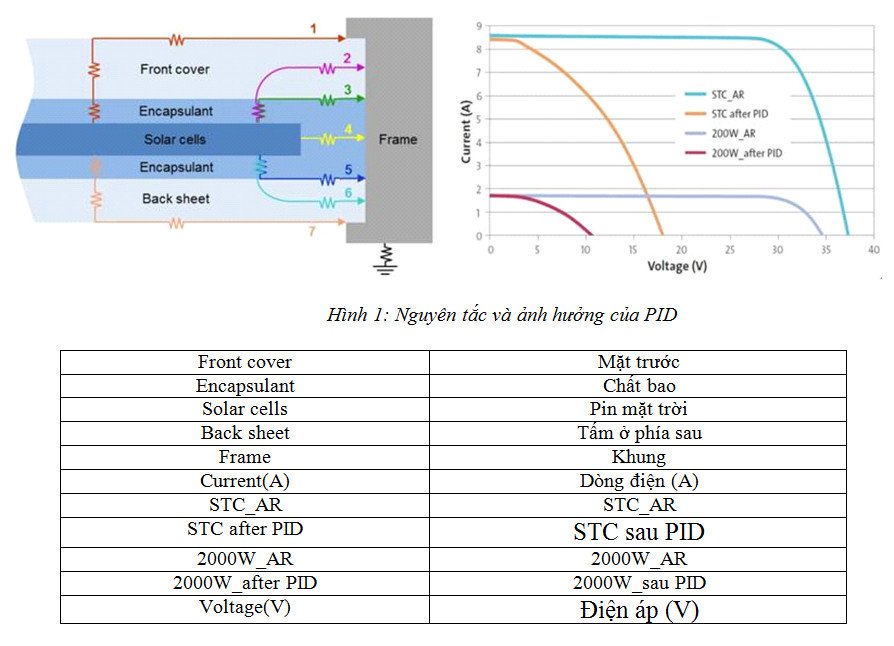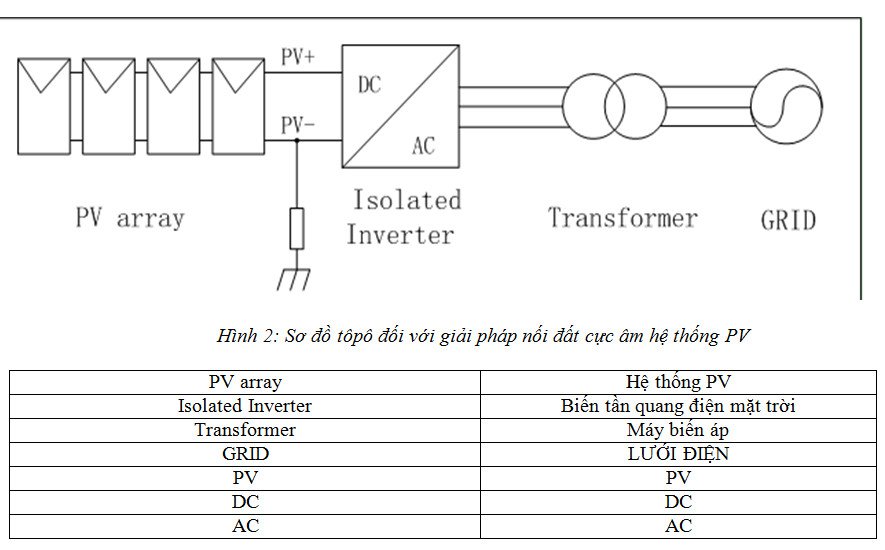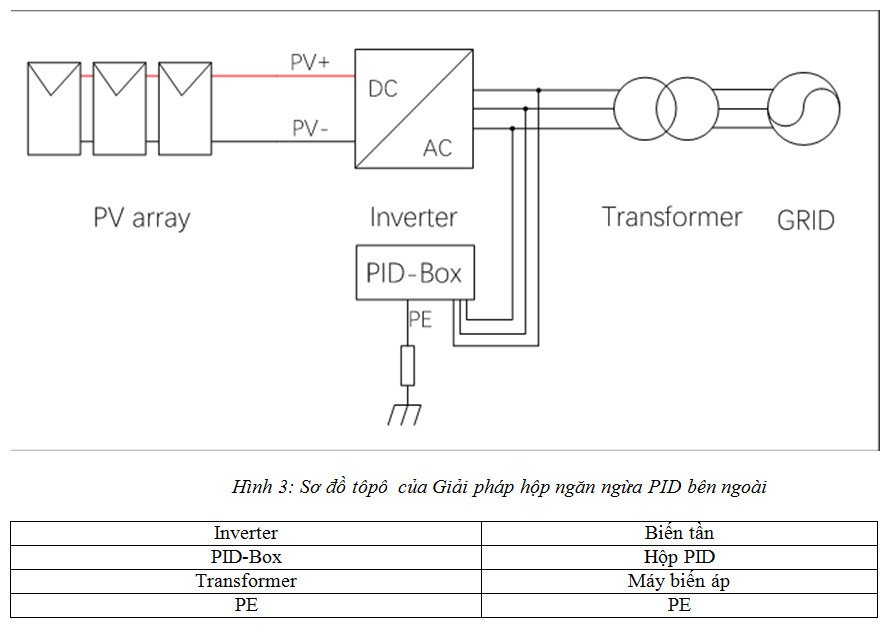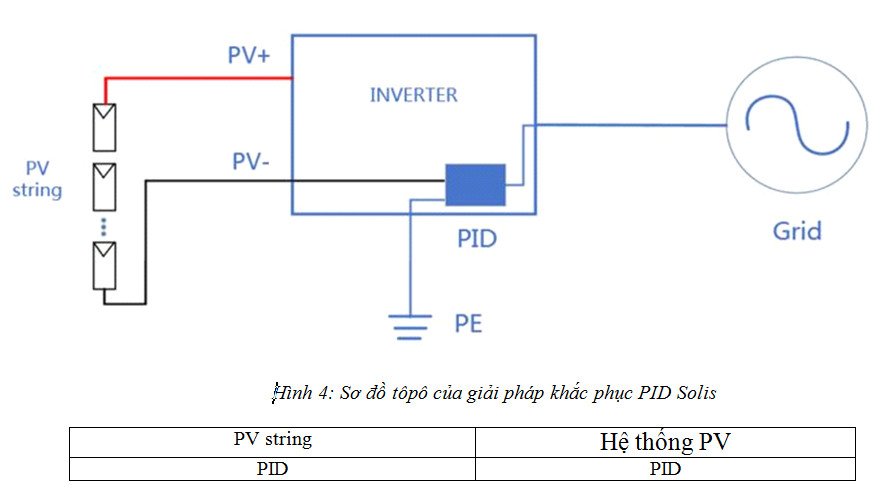Solis Seminar【Episode 23】: Solution for PID Recovery
11:00 | 10/06/2021
Description of Causes and Effects
When the solar cell is polarized with a higher negative voltage, there will be a voltage difference between the cell itself and the other elements of the module (e.g. glass, substructure and frame), thus causing the module’s power output capacity to degrade. This is at zero potential since it is grounded most of the time. Therefore, since the distance between the solar cell and the frame is very short, and because there may be problems in the sealing material, current can be created between the cells and the frame. This generates a current leakage throughout the entire PV module.
This ion migration impacts the electrical characteristics of the solar cell and leads to a power output degradation. The following show measurements taken from PID susceptible PV modules to illustrate the effect and severity of PID.

Figure1: PID principle and influence
PID Solution
There are many types of Anti-PID solution, but mainly include the following three categories:
PV- grounding Solution
In PV plants with galvanically isolating inverters, PID can be prevented reliably by earthing the negative poleof the PV array, as this shifts the potential of the entire PV array to the positive.

Figure2: Topological diagram of Earthing the negative pole of the PV array solution.
However, in PV plants that use transformer-less inverters, this solution requires more measures to meet the requirements of international mainstream safety standards such as IEC62109, UL1741, etc. Several measures should be made while the negative pole is grounded:
(1) Increase GFDI (DC-to-ground fault detection);
(2) Increase the ISO (insulation testing) function;
(3) Implement lightning protection measures.
(4) Ensure that the neutral wire is not connected to the primary side of the transformer, or directly add an isolation transformer for the system which use transformer-less inverter.
AC negative virtual grounding Solution
The solution is to add aPID protection device to provide a virtual grid neutral point N for the inverter of the system. The virtual N point potential is the s equal to the midpoint potential of the inverter internal DC bus, so by raising the virtual N point to ground voltage, we can raise the PV-toground voltage so that the voltage is greater than zeroto make PV- dangling, so as to achieve the effect of anti-PID. But this solution has the following problems:

Figure3: Topological diagram of External anti-PID box Solution
1.The Anti-PID box solution could only be deployed in utility installations which are normally connected to themedium voltage (MV) grid running without neutral line, Therefore, some C&I PV plants that require natural line as power supply cannot be used.
2. Using this solution can prevent the continuous aggravation of the PID problem and cannot restore the PV module power.
PID Recovery solution
It uses the PV module PID reversible principle. This method applies a positive voltage between the PV module and the ground at night to allow the conductive ions, which lost from the PN junction during the day to return, thereby restoring the power generation capacity of the PV cell.
Solis PID recovery solution uses the built-in PID module without additional installation. It is integrated into every large commercial and utility inverter. It uses the PV module PID reversible principle. When the array voltage falls below a defined threshold after sunset, this module will add a positive potential of 600-700V between PV- and the earth. This makes it so the conductive ions lost during the day return to the PN junction, thereby restoring the PV module power generation capacity.

Figure4: Topological diagram of Solis PID Recovery solution
Advantage:
1. It could use in utility installations which are connected to the medium voltage (MV) grid running both with neutral line or not, Therefore, C&I PV plants that require natural line as power supply also can be used.
2. Compared with other solutions, the DC voltage problem is eliminated.1000V,1100V or even 1500V, through the selection of the corresponding inverter, the working voltage of the PID module can perfectly match the system voltage.
Note:
1. The built-in PID module input is AC three-phase power (UVW), and the output port is DC power, which is connected to PV- and earth.
2. During PID module operation, if maintenance is required, please cut off the AC circuit breaker, and then to repair the inverter and the DC side.
3. The inverter needs to be well connected to the earth.
Solution test results
In order to test the recovery effect of the built-in PID module, Solis selected the attenuated PV modules for EL test on site. The test results are as follows:

PID RecoverySolution test results
In order to test the recovery effect of the built-in PID module, Solis selected the attenuated PV modules for electroluminescent (EL) test on site. The test results are as follows:
As shown in Table 1-1, after using the built-in PID recovery solution for 20 and 40 days, the performance of the PV modules affected by the PID has been greatly recovered.

Conclusion
As a terrible factor affecting the power generation of PV power stations, PID effect needs our immediate attention in this industry. As leaders in this field it is obligatory to counter act these detrimental affects. If we don’t do this now, then customers will lose their large investment in a matter of years. This article combined with experiments proves that the built-in PID module has obvious effects in restoring the power generation capacity of PV modules. The PID recovery method is undoubtedly the easiest, quickest, most affordable and most reliable PID solution method.
Sources by Solis.


